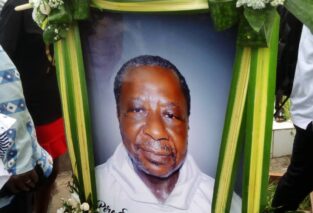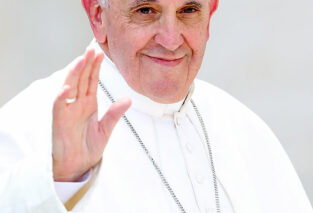There is a beautiful passage in the Apocalypse in which Saint John describes a huge crowd, impossible to count, of people from every nation, race, tribe, and language, prostrating themselves before the Lamb and the Throne, enveloping their praises to the Almighty in songs and prayers (Rev 7:9). Whenever I see the crowd Pope John Paul II pulls wherever he goes, I always recall that biblical passage. It came to mind again on Friday, 15 September 1995 at the Yaoundé Airforce Base where thousands of people had gathered to hear the Holy Father say Mass. That crowd would surely have been much larger had they not been discouraged by the strict security precautions, coupled with the persistent rumour – denied by Church leaders – that only those with invitation cards would be allowed to attend the Mass. Many therefore stayed back at home, glued to their television screens or to their transistor radios. That notwithstanding, the crowd that showed up was still impressive.
Weeping at the beauty of the Church’s music
There were, indeed, men and women and children of every shade and colour, tribe, race and language, most of them dressed in a riot of colours – a magnificent “rainbow” of humanity – who had come out to join the Holy Father around the altar of the Lord, sending praises to the Almighty in songs and prayers. And what a splendid blend of song, rhythm and prayer! As I watched the magnificent performance of the multi-ethnic choir, conducted with such elegance and grace by a well-known musicologist, Reverend Father Etienne Bétené, I thought I could hear, in my mind’s ear, the voice of Saint Augustine, the African Saint, drifting across fifteen hundred years of history, reaffirming the majesty of songs in praise of the Lord. In fact, when moved by the splendour of church songs, Saint Augustine wrote: “I wept at the beauty of your hymns, and I was profoundly moved at the sweet sound of your Church’s singing. Those sounds flowed into my ears, and the truth streamed into my heart. My feeling of devotion overflowed, and the tears ran from my eyes, and I was happy in them” (Confessions, 9, 6).
Long before the start of the Holy Father’s Pontifical Mass, that choir was already softening the hearts, souls and minds of the faithful, and non-faithful alike, preparing them to join the Vicar of Christ around the Lord’s altar.
At 8:30 a.m, hundreds of bishops from the 25 countries present, which ranged from North Africa through West Africa to the great lakes of the Central African region, began to move to the altar in a slow and dignified procession, escorted and serenaded by a group of women choristers, dancing to the rhythm of drums and xylophones. That procession was led by Bishops Jean-Bosco Ntep and Dieudonné Watio of the Dioceses of Edea and Nkongsamba, respectively, then the “benjamin” of the Cameroonian Episcopate.
Shortly thereafter, the Holy Father arrived, standing in a convertible car and waving to the cheering crowd. The xylophones and drums and the siren voices of the women in the choir acknowledged the Supreme Pontiff’s arrival by going into a frenzy of excitement that held the already taut air in its grips for well over ten minutes.
The presidential family
It was when the Holy Father was in the sacristy vesting himself for Holy Mass that the Head of State, Mr. Paul Biya, arrived, accompanied by his wife, Chantal, and her step-son, Frank Biya, a tall, lanky, bespectacled young man, suave and gracefully dressed in an expensive-looking, light blue suit, with Parisian opulence written all over it. He carried himself with obvious elegance and with the sure certainty that he was the centre of all attention and comment from the rest of us – which he was!
The arrival of the President’s family sent dark-goggled, stern-faced security people nervously skipping around as if they were standing barefoot on pins. In their huge hands, walkie-talkies and hand-held phones of various shapes and sizes bullied frantic instructions to the bearers who, in turn, screamed back into them or into the lapels of their jackets.
As I watched the scene, I could not help noting the remarkable difference between the arrival of the Holy Father and the President of the Republic. When the Holy Father arrived, I felt an irrepressible urge to run towards him, to touch him, and feel his comforting hand on my forehead. With the President of the Republic, however, dread overcame me and I felt like fleeing in the opposite direction, for dear life.
At exactly 9:30 a.m, the cardinals, archbishops and bishops, who were to concelebrate the Holy Mass with the Pope, began to make their way to the altar, serenaded by the music from the choir. For his part, the Holy Father took a shorter route from the sacristy to the altar. In fact, many people, who were scanning the approaching procession of bishops, hoping to catch a glimpse of the Holy Father, were surprised and slightly disappointed that he was already at the altar.
Bilingual presentation
The highlights of that Mass were, undoubtedly, the speech by Monsignor Jean Zoa, whose Archdiocese of Yaoundé was the host of the occasion, and the Holy Father’s homily.
Archbishop Jean Zoa, moving with relative ease from French to English, began by recalling “the profound trauma and the mutilations” the black race has suffered from slavery through colonialism and now neo-colonialism, and reminded the world that such acts did not only dishonour the African “but the whole human race.”
He then mentioned that it was now time for reconciliation with our past as a way of finding “grounds for a realistic and creative optimism” without which we cannot “create a universal, Trinitarian and communitarian culture based on a mutual exchange of gifts.” That is why, he continued, inculturation “must be firmly rooted in a deep experience of conversion.”
He then called on the African laity to “take the destiny of Africa into their hands as baptised Christians committed to spreading the Gospel of Jesus Christ, as leaders and servants of their communities, as builders of history and stewards of the earthly city.”
Early African theologians.
For his part, the Holy Father recalled the history of evangelisation in Africa, dating from the dawn of Christianity when Christ had given the injunction to his disciples to go out to all the nations of the world, making converts and baptising them in the name of the Father, and of the Son and of the Holy Spirit (Mt 29:19). He stressed the evangelisation role played by African theologians of the early era of Christianity, notably Saint Augustine, a man Pope Paul VI called “One of the most brilliant lights of the Christian world.”
The Synod of the entire continent
He then gave a brief history of the recent Special Assembly of the Synod of Bishops for Africa that met in Rome in April and May 1994, and whose results he had come to promulgate in Yaoundé. He defined a synod as the meeting of roads along which the Church moves in various countries and continents of the world. He said that even though the synod tradition was not new in Africa, it was the first time ever that a synod had been entirely dedicated to the continent, from the Cape of Good Hope to Cairo, and from the Horn of Africa to the slave fort of Gorée, off the coast of Senegal.
To reflect the multi-national nature of the Yaoundé meeting, the Supreme Pontiff sent greetings in Portuguese to the Lusophone communities of Cape Verde, Guinea Bissau, and Sao Tome and Principe islands. In Spanish, he spoke to the Hispanophone community of Equatorial Guinea, and in English, he saluted the Anglophone communities of West Africa and used the Queen’s language to comment on the Gospel of the day from Saint Luke in which Jesus applies the words of prophet Isaiah to himself in the synagogue, thus identifying himself as the long-awaited Messiah, bearer of the Good News of salvation to the poorest of the poor (Lk 4: 14-21).
The Holy Father continued that the Good News would have to be infused into the very veins of African cultures and traditions through the process of inculturation. If culture was the art of cultivating the vineyard of the great African continent, inculturation must be all that confirms the presence of Christ in African cultures, that is, in African languages, literatures, songs and dance, and in the way of celebrating the Eucharist. With those words, the Holy Father placed the stamp of his pastoral approval on ceremonies such as the Lectionary procession that the Nso choir led and the Offertory procession, inspired from a Zairean ritual, both of them having played a prominent part during that Holy Mass.
Spread the message of the Synod.
It was also during that Pontifical High Mass that the Holy Father gave copies of the Post-Synodal Apostolic Exhortation, Ecclesia in Africa, that he was to promulgate that afternoon at the Our Lady of Victories Cathedral, to a number of people, including cardinals, archbishops, bishops, priests, religious and Christ’s lay faithful.
He then urged them to make its content known to everyone in their farms, on the street, at their jobsites, in their families, from one generation to another. History will have it on record for eternity that it was in our land, in the year of our Lord 1995, on the 15th day of the month of September, that the Supreme Pontiff of the Universal Church, the Servant of the servants of God, John Paul II, on his 75th year on earth, and on the 17th year of his pontificate, promulgated the Post Synodal Apostolic Exhortation: Ecclesia in Africa. May God bless our country, Cameroon! Amen.
(Reproduced from L’Effort camerounais, No 31 (1028) of September 23 – October 06, 1995, p. 15).
Douala, April 30, 2014


